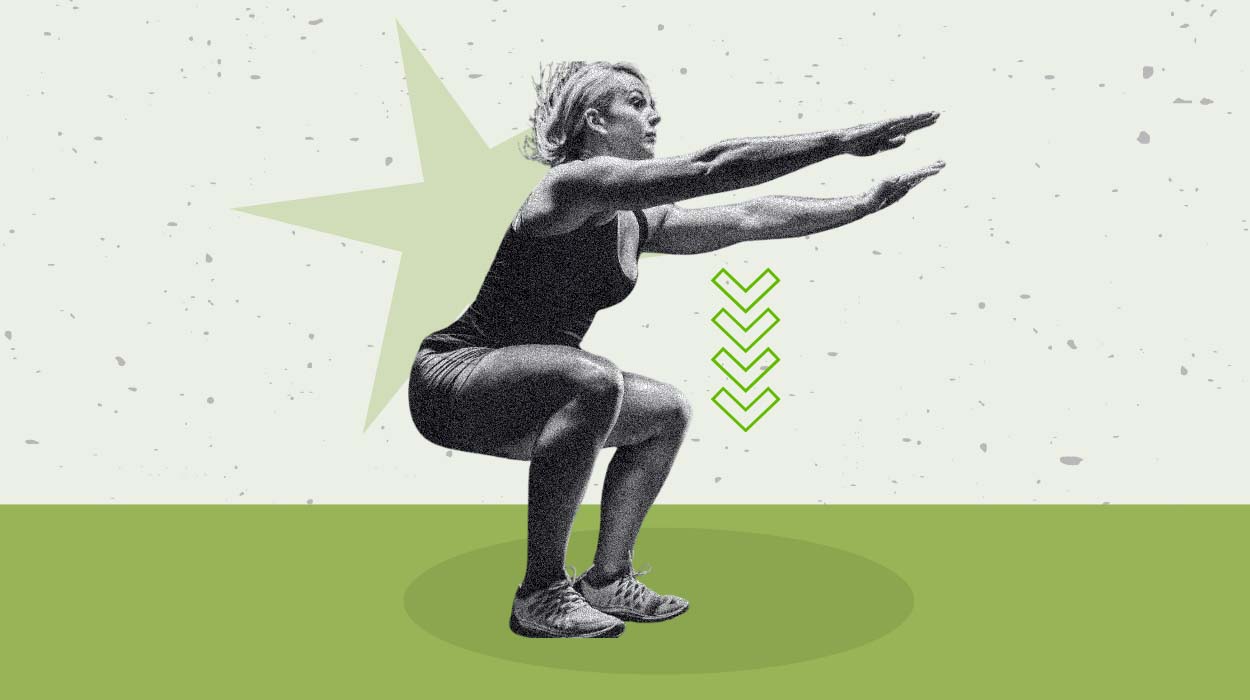
Jumping is an important component of many sports like basketball, soccer, football, and volleyball. Being able to jump higher could give you an advantage over your opponents. On the other hand, some of you may only want to improve jump performance for personal satisfaction. Regardless of why you want to jump higher, below are six exercises to jump higher, tips, and more. The main idea is to strengthen and condition the jump-specific muscle groups and practice your jump movement pattern.
Exercises For Jumping Higher
Exercises To Jump Higher
There are many lower body exercises that you could use for vertical jump training. We have discussed six exercises that may help.
Barbell Back Squat
The barbell squat is great because it overloads and activates the exact muscle cells that would be used in the vertical jump. This includes the calf muscles, quadriceps, glutes, and lower back. Over the long term, these muscle groups could get bigger, stronger, and more conditioned for vertical jumping.
Secondly, the barbell back squat may improve the movement pattern of the vertical jump by drawing the same chain of movements (ankle, knee, hip).
A 2016 study[1] from the Journal of Strength and Conditioning Research, looked at the effects of 8 weeks of barbell squat training on vertical jump performance. The researchers found that barbell squat training twice per week improved vertical jump performance by 12.5%.
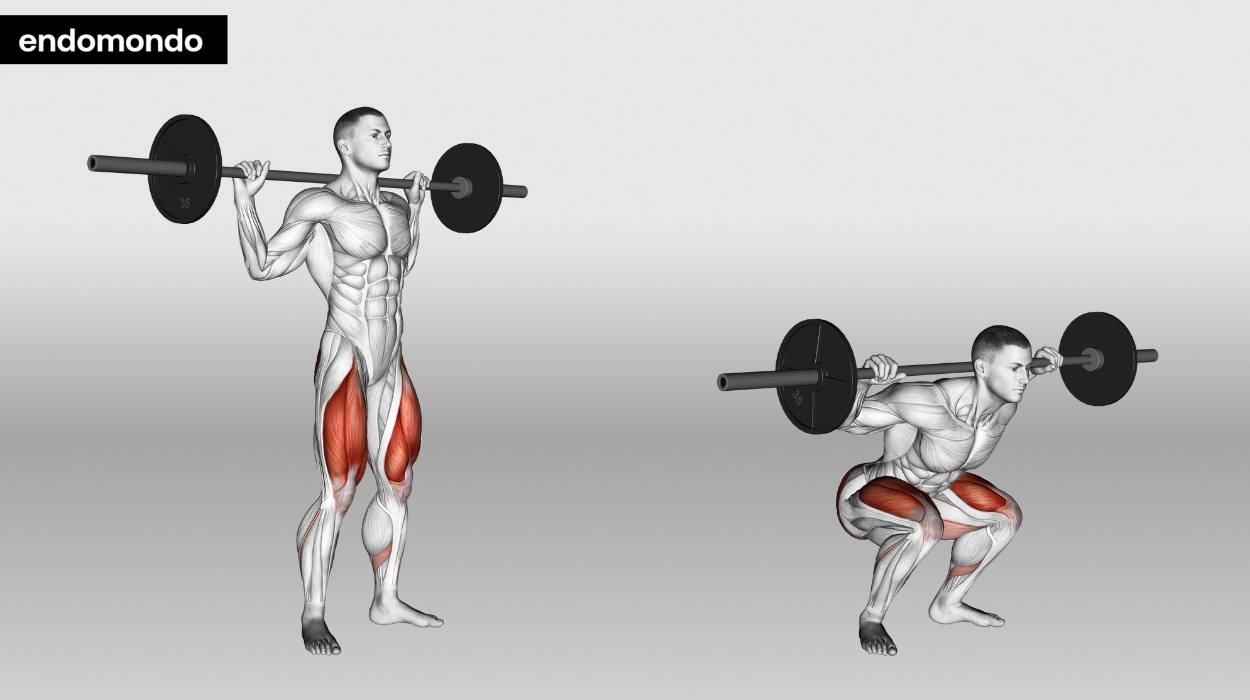
How to do:
The barbell back squat and the vertical jump share similar mechanics. Both use the triple extension of the lower body. To be specific, the movements draw into a squat position, followed by pushing the feet off the ground (plantar flexion), straightening at the knees (extension), the hips (extension), and then the lower back (extension).
The difference is that the barbell squat may place more stress on the working muscles, whereas the vertical jump takes the body off the ground.
- Balance a barbell on the upper back with the feet shoulder-width apart
- Squat downwards and then stand back up with explosive power.
Tips:
- Maintain proper form to reduce the risk of injury.
- Control your descent to engage the target muscles effectively and maintain stability.
- Focus on pushing through your heels rather than your toes as you begin to ascend from the squat to ensure proper force distribution
Optimal Sets And Reps: 65-100% intensity within a rep range of 1-14 and 3-5 sets. If you are also using other exercises, squatting once or twice per week could work well.
Barbell Deadlift
Another 2015 study[2] from the Journal of Strength and Conditioning Research, looked at the effects of 10 weeks of barbell deadlift training on vertical jump power and performance. The participants were novices who performed deadlift training twice per week.
At the end of the study, the participants who used the barbell deadlift went from 18.8% to 49% torque. Vertical jump height also improved by 7.4%, which give or take is a 3.4 centimeters difference.
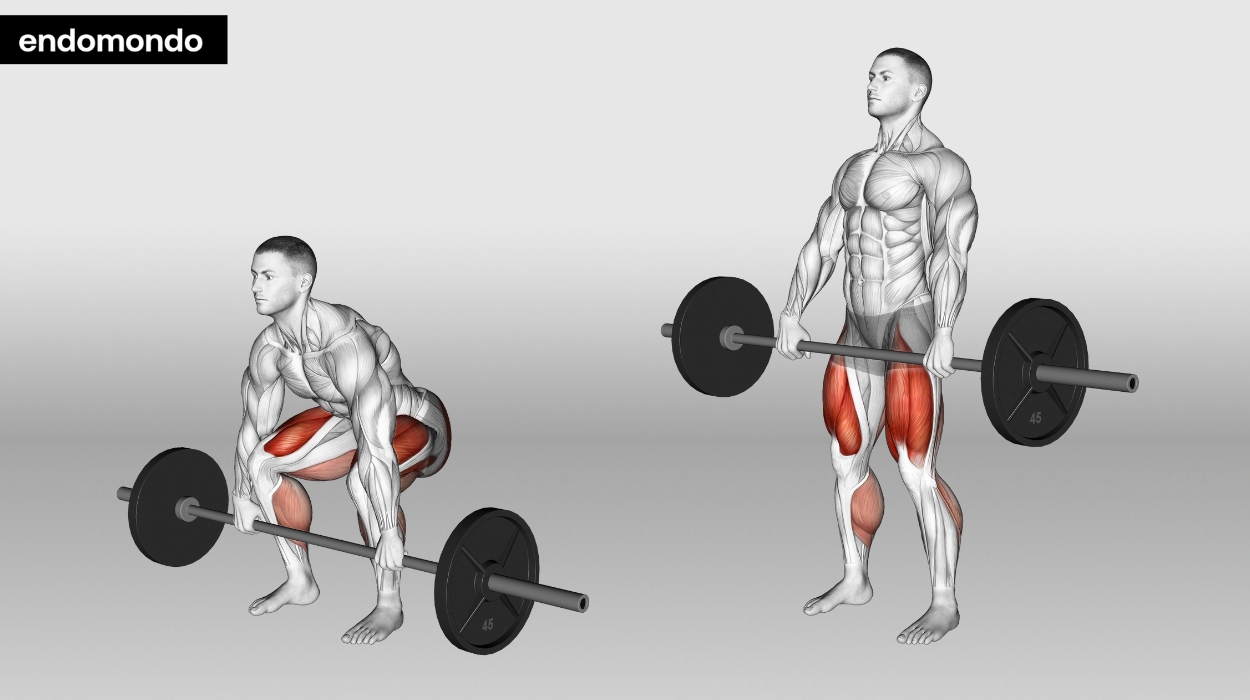
How to do:
The barbell deadlift is another lower body exercise that uses similar muscle groups and movement patterns to the vertical jump.
- Position the feet hip-width
- Lift a loaded barbell off the ground with the simultaneous and explosive extension of the lower body (jump motion). In turn, this may add more stimulus to the jump-specific muscles, which could condition them over time.
Tips:
- Engage your core and keep your spine in a neutral position as you prepare to lift the barbell.
- Focus on using the power from your lower body rather than relying solely on your back muscles.
- Start with lighter weights and gradually increase as you become comfortable with the exercise
Optimal Sets And Reps: 65-100% intensity within a rep range of 1-14 and 3-5 sets. If you are also using other exercises, squatting once or twice per week could work well.
Box Jump
Without a doubt, jumping exercises like the box jump are identical to the vertical jump in motion. One difference that I can highlight is that you are landing on a box, which practices coordination.
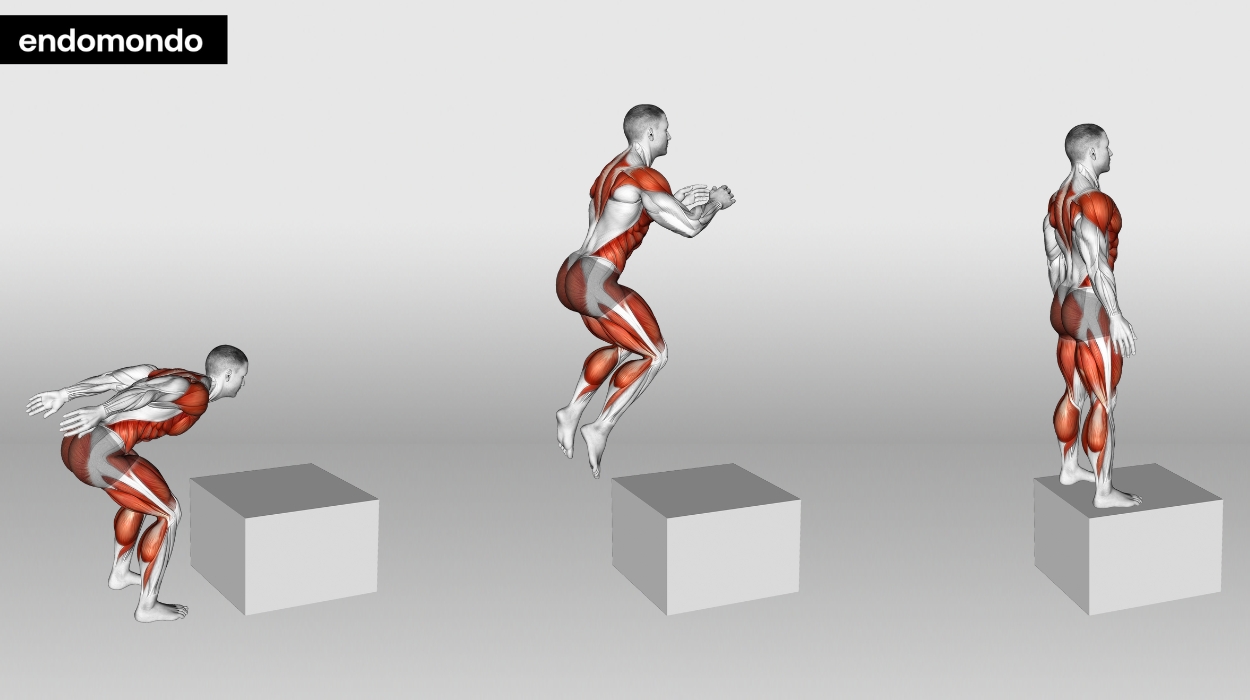
How to do:
Overall, the box jump is a great way to make jump height goals and improve jump efficiency and power.
- Set up some boxes that you are physically capable of jumping on top of.
- Do a vertical jump with the arms forward, then land softly on top of the boxes on the balls of your feet with the knees slightly bent. This will help condition the Achilles tendon, which is crucial for jumping.
Tips:
- Always warm up before attempting box jumps
- Choose the appropriate box height for your fitness level and jumping ability.
- Land softly and safely to reduce stress on your joints and minimize the risk of injury.
Optimal Sets And Reps: Reps to failure with 3-4 sets.
Single-Leg Vertical Jump
Incorporating the single-leg vertical jump into your routine can improve lower body strength, balance, and coordination. The explosive jumping action helps to develop power and increase vertical jump height, making it beneficial for individuals who want to enhance their jumping ability for sports like basketball or volleyball.
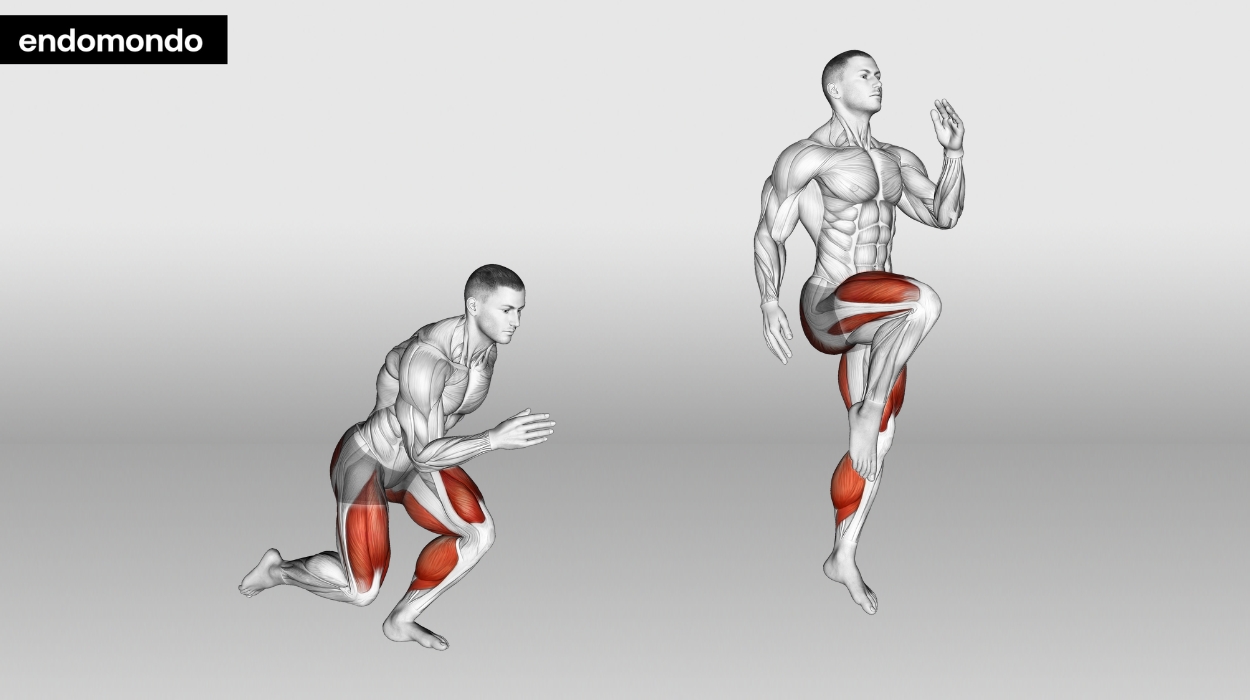
How to do:
This exercise is basically the normal squat but places all of the tension on one leg at a time. As this exercise is performed on one leg, it may improve core stability and balance, which can then translate into a more effective vertical jump performance.
- Squat upwards.
- Jump straight after that.
Tips:
- Focus on a fixed point in front of you to maintain stability.
- Keep your weight centered on your standing leg and avoid leaning too far forward or to the side.
- Start with a controlled motion and gradually increase the intensity and height of the jump.
Optimal Sets And Reps: Reps to failure with 3-4 sets, alternating between legs.
Pause Jump
The pause jump can be used in times when you want to work and build on the jump muscles alone, with lower tendon activation. Why so? During the pause jump, you are not using the downward momentum and then bouncing up by hitting the tendons of the lower body, like the vertical jump.
This is not to say that you should not work on the tendons, but this exercise can be used when you want to emphasize the lower body muscles as much as possible.
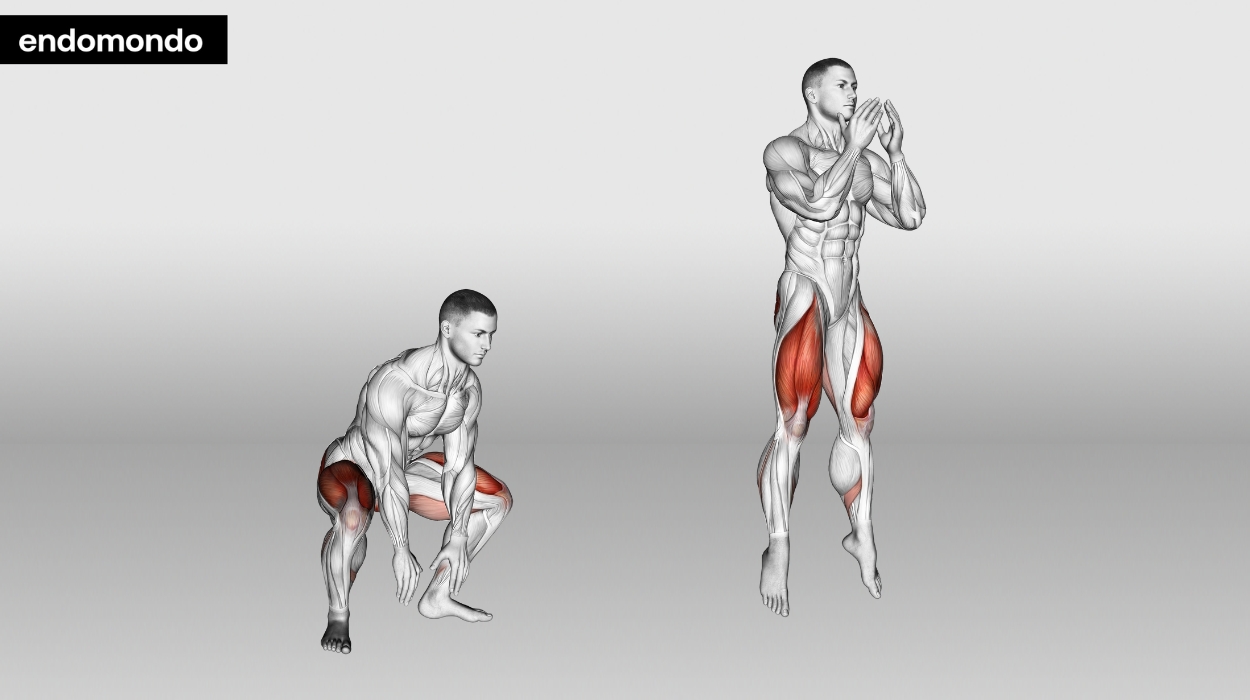
How to do:
- To get into the starting position, squat down and pause with the knees bent and hands close to the hips.
- Jump up, while swinging the arms forward.
Tips:
- Start with proper positioning to generate power and stability for the jump.
- Start with smaller pauses and gradually increase the duration as your strength and coordination improve.
Optimal Sets And Reps: Reps to failure with 3-4 sets.
Jump Squats
The jump squats would increase the level of tension on the jump-specific muscles, which may then condition them for a more impressive vertical jump over the long term.
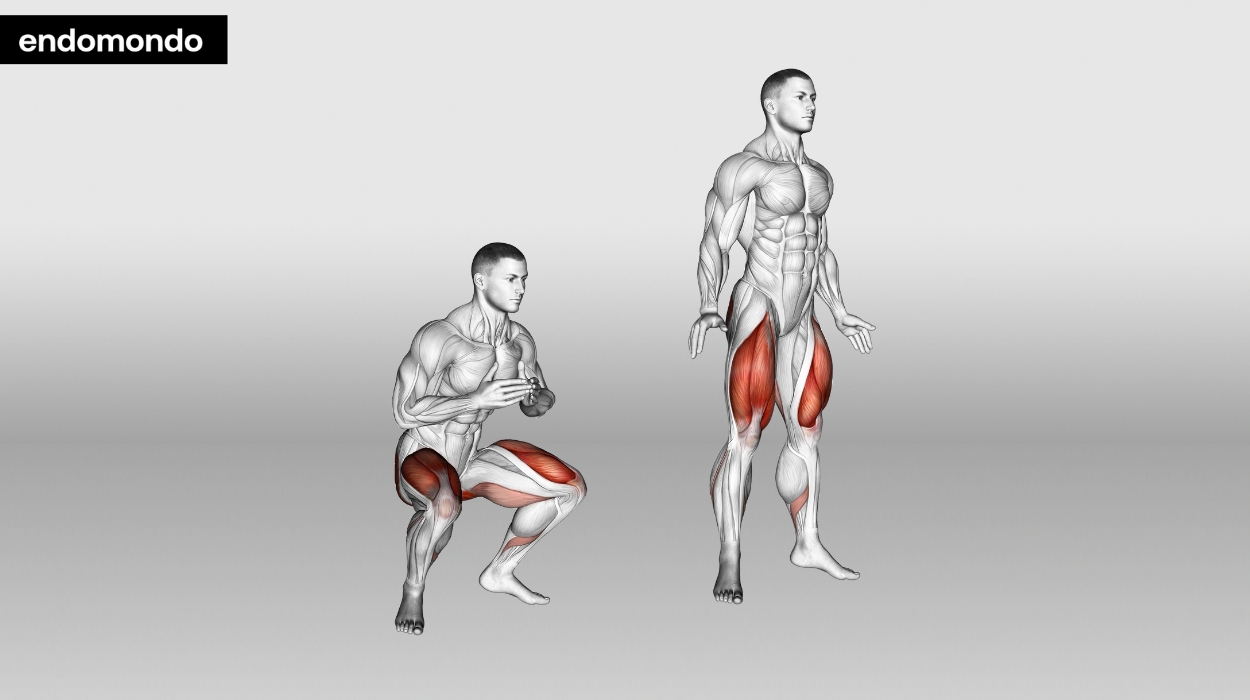
How to do:
- Do a vertical jump
- Sprawl back into a squatted position.
Tips:
- Keep your back straight and avoid rounding your shoulders when jumping.
- Remember to land softly by bending your knees and absorbing the impact as you return to the starting position.
Optimal Sets And Reps: Reps to failure with 3-4 sets.
Tips To Help You Jump Higher
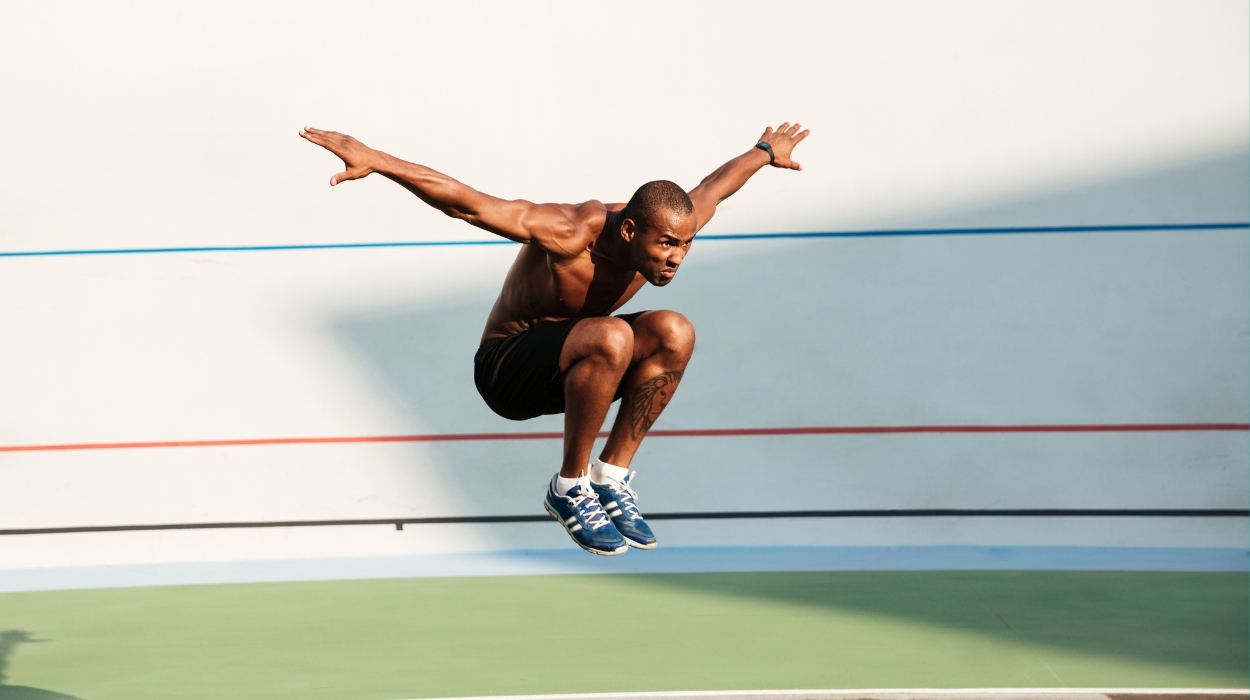
Observe Proper Nutrition
Eating a healthy amount of carbohydrates can help fuel your high-intensity workouts and improve athletic performance. Carbohydrates are eaten, digested, and converted into chains of glucose that make glycogen. Glycogen is stored in the muscle, liver, and brain to be used as energy for exercise and activity.
Without getting into detail, glucose is broken down through three mechanisms during exercise. What you need to know is that each gram of glucose yields around 38 ATP energy molecules, thus highlighting the importance of observing a carbohydrate-rich diet.
It is difficult to give a general recommendation for carbohydrates because it will entirely depend on your individual activity level. This could be anywhere from 3-8g of carbohydrates[3] per kilogram of body weight.
So the biggest takeaway would be to include high-carbohydrate foods into your diet if you are not already doing so. This could include rice, pasta, bread, fruits, etc.
Secondly, another macronutrient that holds importance is dietary protein. Protein is made up of nine essential amino acids, which can activate muscle protein synthesis (muscle building), which can support the growth and repair of jump-specific muscles over the long term.
Once again, general recommendations are very difficult to give, but for someone who is trying to increase muscle size and strength around their jump-specific muscles, we could aim for 1.2-1.7g per kilogram of body weight. This amount of protein tends to help basketball players[4] improve their running and jumping performance.
To get an idea of high-protein food sources, you could consume whey, egg, milk, chicken, beef, fish, soy, etc.
Improve Jump Technique
You should focus on proper jumping techniques to ensure that you tap into all of the jump-based muscles and tendons. This could maximize your jump performance while reducing the risk of injury from using proper body mechanics.
For a proper vertical jump technique, try placing the feet hip-shoulder width apart and shifting your body weight onto the heels. This would be followed by bending at the knees and hips, then tilting the torso forwards, while pulling the arms behind the body.
With maximal exertion, press the balls of the feet against the ground, then extend at the knees, hips, and lower back. Last but not least, swing the arms forward while taking off the ground. Remember that in real time this movement would be done rapidly without any pauses
Exercise Regularly
To maximize your jump performance, you must turn up to all of your workouts and training sessions. This can speed up the process of building jump-specific muscles and perfecting your movement pattern.
When To Talk With A Coach Or Fitness Professional?
Coaches and fitness professionals can be an asset rather than a necessity to your fitness journey. We would suggest talking to a fitness professional if you are begging and do not have any understanding of exercise and fitness. A fitness professional will be able to guide and teach you about the basics.
The second instance where you may want to talk to a fitness professional would be if you have hit a fitness plateau. This means that you have improved so much that you are finding it difficult to get any better.
What Muscles Do You Use For Jumping?
While jumping, four main muscle groups[5] come into action. We have broken down each individual muscle below.
Calves
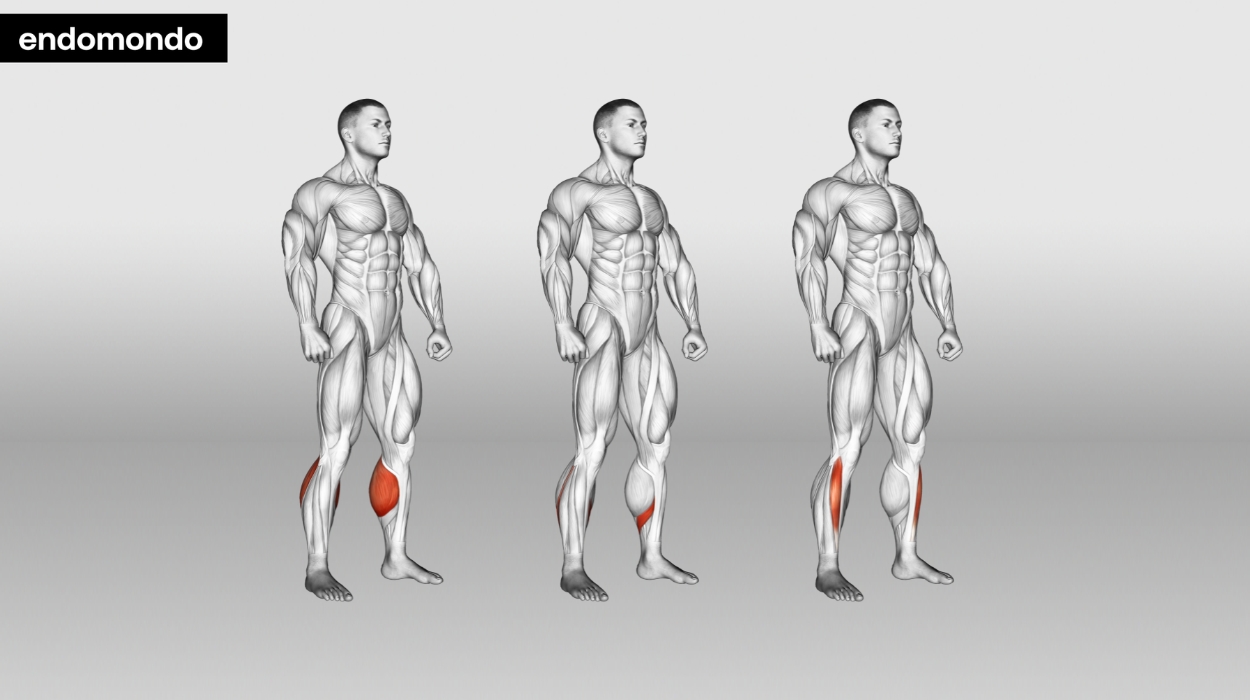
The calves are made up of three small lower-leg muscles. These muscles perform two main movements. The first movement is dorsiflex, which is where you would point the toes upwards. The second movement is plantar-flex, which is pressing the front foot against the ground. These movement actions are essential to start a jump. All three muscles have been mentioned below.
- Gastrocnemius (Back of lower leg)
- Soleus (Outer lower portion)
- Tibialis anterior (Front of lower leg)
Quadriceps
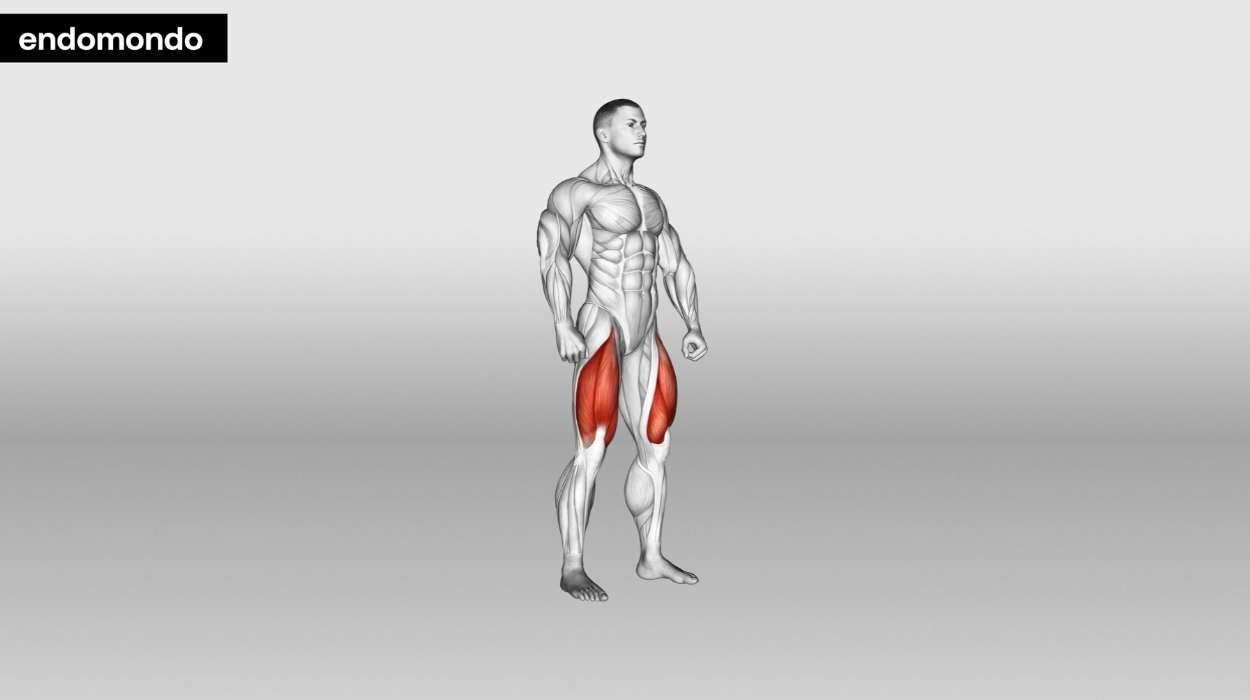
The quadriceps are four small string-like upper thigh muscles that are responsible for extending at the knee joint formally known as straightening the lower leg. The second part of a Jumps draws this movement. Each quadricep muscle has been highlighted below.
- Vastus lateralis (Upper thigh)
- Vastus medialis (Inner thigh)
- Vastus intermedius (Middle thigh)
- Rectus femoris (Deep middle thigh)
Glutes
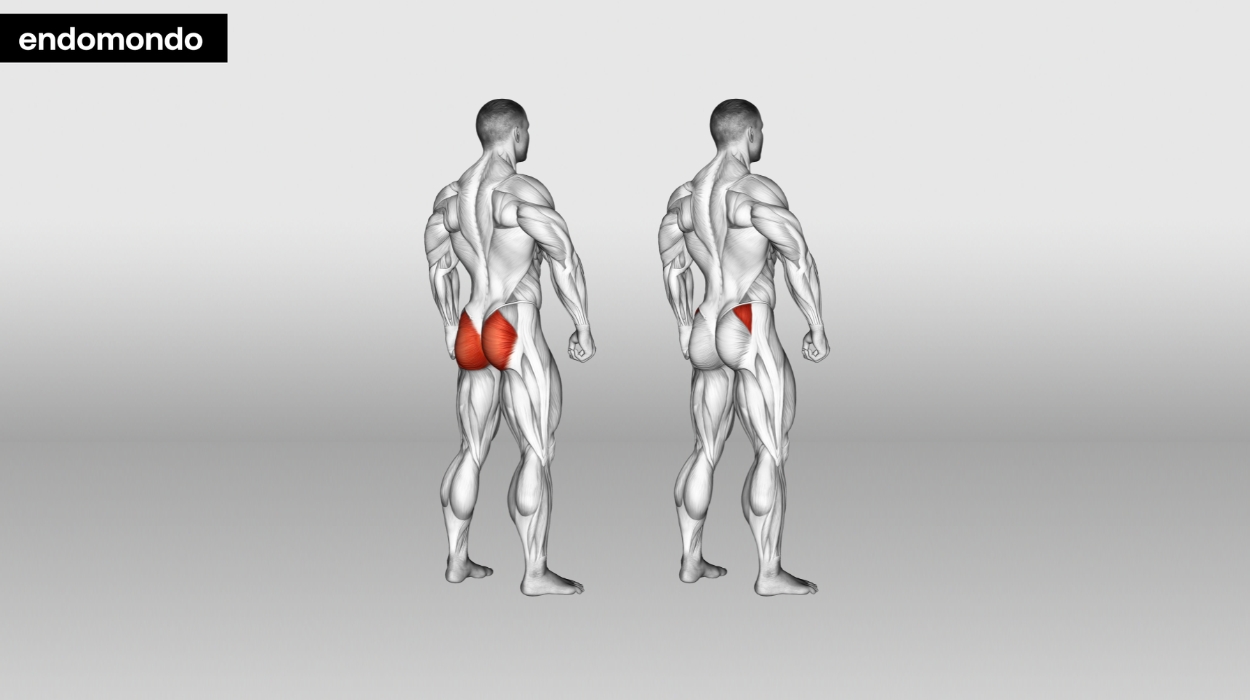
The glutes are the buttocks muscle groups. The glute muscles are important for a variety of hip joint movements. During jumping, one of the most important muscles is the glute max, which extends the hip joint during the thirst part of the jump. This movement is also known as straightening the hip. The three glute muscles have been labeled below.
- Gluteus medius (Hip muscle)
- Gluteus maximus (Buttocks)
- Gluteus minimus (Deep hip muscle)
Lower Back
There are many muscles in the back. We are interested in the lower erector spinal muscles as they help to extend the lower back while jumping, just before swinging the arms forward.
- Erector spinae
How To Measure Your Vertical Jump?
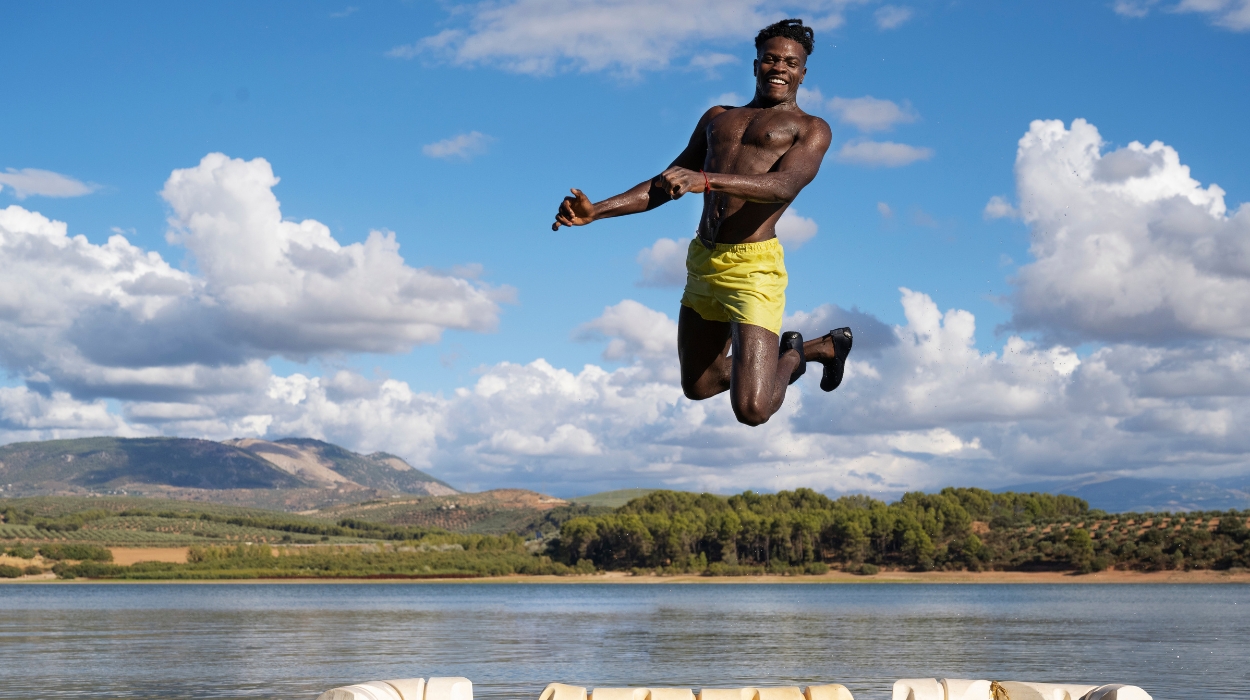
There are many ways to measure your vertical jump height. We have included a basic six-step process.
- Stand beside a wall on a hard flat surface, giving yourself enough space to perform a vertical jump (Preferably outdoors)
- Wrap the tip of the middle finger of your dominant hand with double-sided tape that is loose enough to come off and stick onto the wall
- Stand on the ground and stick the tape on the wall to identify your standing reach height
- Put a new piece of tape around the finger perform a vertical jump and slam the sticky tape on the wall
- Repeat this process three times with a one-minute rest in between each jump
- Using a metal measuring tape, record the length from the standing reach height to each vertical jump, then divide the recordings by three.
Additional Information: An example of this could be that your standing reach height is 40 inches and your vertical jump height may be 65 inches. You would deduct the jump height from the standing reach height giving you your vertical jump (65 – 40 = 25 inches ).
Conclusion
All in all, we have learned that there are four core muscles of the lower body that are used while jumping.
To improve jump height, you must strengthen the muscles and the jumping movement pattern, which can be done by using the six exercises that we have mentioned.
We must not forget to observe good nutrition to fuel our exercise sessions, as well as help build the muscles. Other tips include jumping with proper form and technique and not missing a workout.
The only time I would suggest reaching out to a coach or fitness professional would be if you are a total newbie or you have hit some jump plateaus, thereby you could get some guidance on what to do next.
Last but not least, for those who want to do some before and after testing on your jump height, you could use the simple tape and wall method that we mentioned in the article.
Frequently Asked Questions
It is difficult to say, but with the two studies that we mentioned, barbell squats improved jump height by 12.5%, whereas the deadlift only improved it by 7.4%.
The whole lower body, but if I had to highlight one it would be the quadriceps.
Resources
- Wirth, K., Hartmann, H., Sander, A., Mickel, C., Szilvas, E. and Keiner, M. (2016). The Impact of Back Squat and Leg-Press Exercises on Maximal Strength and Speed-Strength Parameters. Journal of Strength and Conditioning Research, [online] 30(5), pp.1205–1212. doi:https://doi.org/10.1519/jsc.0000000000001228.
- Thompson, B.J., Stock, M.S., Shields, J.E., Luera, M.J., Munayer, I.K., Mota, J.A., Carrillo, E.C. and Olinghouse, K.D. (2015). Barbell Deadlift Training Increases the Rate of Torque Development and Vertical Jump Performance in Novices. The Journal of Strength and Conditioning Research, [online] 29(1), pp.1–10. doi:https://doi.org/10.1519/jsc.0000000000000691.
- Escobar, K.A., Morales, J. and Vandusseldorp, T.A. (2016). The Effect of a Moderately Low and High Carbohydrate Intake on Crossfit Performance. International journal of exercise science, [online] 9(3), pp.460–470. Available at: https://www.ncbi.nlm.nih.gov/pmc/articles/PMC5065325.
- European Journal of Sport Science. (2023). Dietary Habits and Fluid Intake of a Group of Elite Spanish Basketball Players: A Need for Professional Advice? [online] Available at: https://www.tandfonline.com/doi/abs/10.1080/17461390400074204.
- Krzysztof Maćkała, Jacek Stodółka, Siemieński, A. and Čoh, M. (2013). Biomechanical Analysis of Squat Jump and Countermovement Jump From Varying Starting Positions. Journal of Strength and Conditioning Research, [online] 27(10), pp.2650–2661. doi:https://doi.org/10.1519/jsc.0b013e31828909ec.




